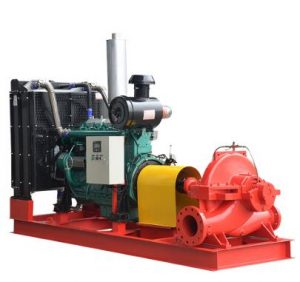The reason why diesel engine belch out blue smoke during the diesel engine fire pump group operation
The national standard name of diesel engine fire pump is ” engineering diesel engine fire pump group”, and the national standard model is XBCL/Q, where L is the head value and Q is the flow value. XBC diesel engine fire pump set is the latest national standard GB 6245 – 2006 ” Fire Pump Performance Requirements and Test Methods”. This series of products has a wide range of lift and flow, and can completely meet the fire water supply for various occasions of industrial and mining enterprises such as warehouses, docks, airports, petrochemical industries, power plants, liquefied gas stations, textiles, etc.
Exhaust emission of blue smoke is usually caused by diesel engine using for a long time and slowly starting to burn engine oil. With the increase of blue smoke and more and more engine oil burning, it is necessary to consider repairing the diesel engine. Sometimes water is mixed in the fuel, or water leaks into the combustion chamber, causing changes in the combustion, and diesel may emit light blue smoke.
The main factors affecting the formation of blue smoke are:
- The air filter is blocked, the air intake is not smooth or the oil level in the oil basin is too high ( oil bath type air filter ), which reduces the amount of air entering the cylinder and changes the normal proportion of fuel gas mixture, resulting in incomplete combustion of fuel with more oil and less gas and also causing blue smoke in the exhaust.
- The lubricating oil in the oil pan is added too much, and the lubricating oil easily rushes into the combustion chamber during the operation of the diesel engine.
- Long-term low load ( less than 40% of the nominal power ) operation, the clearance between the piston and the cylinder liner is too large, which makes the lubricating oil in the oil pan easily run into the combustion chamber, mix with the fuel mixture in the cylinder, change the normal proportion of the mixed gas, burn incompletely, and cause the exhaust to emit blue smoke.
- The piston ring is stuck or worn too much, and the elasticity is insufficient. When the piston ring is chamfered in the installation direction, the oil enters the combustion chamber, and the blue water vapor is emitted after the lubricating oil is burned.
- The cylinder head gasket near the oil passage of the cylinder head is burnt, the pistonand the cylinder liner wear and the piston ring counterpart will cause the lubricating oil to ignite the combustion chamber and burn together with the fuel mixture.
- The ventilator of the crankcase respirator and the atmosphere is blocked, resulting in a large exhaust gas pressure in the crankcase, and the combustion chamber of the oil is burned.

